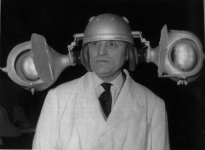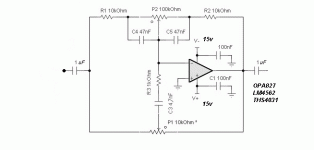Member
Joined 2009
Paid Member
I still favour the Vbe multiplier. Mostly because it's what I'm used to. It's easily adjustable and you can stick it on the heatsink. Diode's have to be soldered together in a string, their bare leads insulated (not so easy if you have to solder them first) and then all of them glued to the heatsink.
And I'd still suggest that if it must be diodes, a resistor is needed to allow for adjustment. Does this resistor change the simulated performance of the diodes - I guess not since it's a linear element. But when I have simulated temperature dependence in the past I have found this resistor important as it can affect how much influence the diode's temperature dependence has over the bias current.
And I'd still suggest that if it must be diodes, a resistor is needed to allow for adjustment. Does this resistor change the simulated performance of the diodes - I guess not since it's a linear element. But when I have simulated temperature dependence in the past I have found this resistor important as it can affect how much influence the diode's temperature dependence has over the bias current.
FWIW I have been using the 2SA1381 as vbe - hfe=~300.
Sounds fine to me!

The MPSA18 has a minimum Hfe of 500, whereas the 1381 has 40. It's power dissipation and other factors are of little significance since it'll only have say 1.5V at 9mA. It is readily available at all online stores, and, if I were to guess, cheaper than the 1381.
So we can be safe and frugal at the same time here.
There are a whole squad of people who might have a differing opinion on multipliers, we want to accommodate them all, and come out with a product that stomps nonetheless. (Hugh, I think I'm picking up on your hype!)
I won't be picky here. I like the diodes but I wouldn't know how important the difference is. Though my vote is on the MPSA18 since Hugh favors the diode string and it is the next best imitation. This way we appeal to both crowds.
- keantoken
Last edited:
Member
Joined 2009
Paid Member
Hi Gareth,
Hope I get you before you retire....
What about the HAKSA? It neatly encapsulates Headphones, AKSA, and the bunch of hacks putting it together.... it's also the name of a city in South Jeolla province in Korea, a textile company in Turkey, and and electrical control company in Bangalore, so it has a credible heritage.
Hugh
Hope I get you before you retire....
What about the HAKSA? It neatly encapsulates Headphones, AKSA, and the bunch of hacks putting it together.... it's also the name of a city in South Jeolla province in Korea, a textile company in Turkey, and and electrical control company in Bangalore, so it has a credible heritage.
Hugh
The MPSA18 has a minimum Hfe of 500, whereas the 1381 has 40. It's power dissipation and other factors are of little significance since it'll only have say 1.5V at 9mA. It is readily available at all online stores, and, if I were to guess, cheaper than the 1381.
The 2SA1381 I use is the "F" type (highest hfe class) and has a measured gain of ~300. Look at it here.
The MPSA18 is a TO-92 and faces the same problem of heatsink mounting, whereas the 2SA1381 has a mounting hole, being a TO-126.
Being in current production by Fairchild, it's not difficult to get the 2SA1381 / KSA1381 - Digikey, Mouser, Newark, Arrow, etc.
With that said, the BD139 will do in that position, as it has in countless other amp before this. The differences (if any) shouldn't be heard; it is after all just the source of DC bias for the output stage.
A suggestion: Why don't you room for both TO220 and TO126 devices? You could even take one or more TO92's. It's an obvious advantage to use TO220 since you have many more devices to choose from than TO126. You could also add SOT23 footprints for the small signal transistors. 

Use a transistor which you can clue to the output transistors.John,
I agree...... the diodes sure are simple, but the heatsink mounting is a PITA.
Hugh
John,
I agree...... the diodes sure are simple, but the heatsink mounting is a PITA.
Hugh
I don't have a qualified opinion on diode vs. multiplier. But solving the mounting issue is trivial, in my opinion. It's a completely different matter than mounting a component that generates significant heat. In that case, heat transfer rates are important. Intimate contact with the heatsink or other part is essential.
In the case of mounting diodes, which are really just measuring devices here, the heat transfer rate in much less important. The sink won't heat instantly, and the diode thermal mass is low. All that has to be done is to have the diode next to the source it's measuring. Then just put a little insulation over the diode(s) to trap the air and heat radiating from the sink/output transistor and you're done.
Sheldon
Last edited:
Member
Joined 2009
Paid Member
Hi guys
I support the LM317 configuration Hugh offered us to look at. It remains simple and almost everyone has had some experience with LM317. It is an overall a predictably good performer. Adding Hugh's common mode rejection chokes follows his ideas in keeping it with the AKSA "sound".
Since Hugh cannot accommodate all, I propose that I design the power supply as a snap-off section so those with other ideas can replace the standard version by simply snapping off the on-board PSU section.
At this point I am not sure Hugh should accommodate the old geysers needing HF boost but maybe Hugh would not mind offering a simple add on bass/treble control that can be placed in front of the amp as a separate item. Maybe this board could contain the cross-feed control and this become an add on for those who feel they need it.
The base design thus remains a simple no frills headphone amp as intended.
Kind regards
Nico
I support the LM317 configuration Hugh offered us to look at. It remains simple and almost everyone has had some experience with LM317. It is an overall a predictably good performer. Adding Hugh's common mode rejection chokes follows his ideas in keeping it with the AKSA "sound".
Since Hugh cannot accommodate all, I propose that I design the power supply as a snap-off section so those with other ideas can replace the standard version by simply snapping off the on-board PSU section.
At this point I am not sure Hugh should accommodate the old geysers needing HF boost but maybe Hugh would not mind offering a simple add on bass/treble control that can be placed in front of the amp as a separate item. Maybe this board could contain the cross-feed control and this become an add on for those who feel they need it.
The base design thus remains a simple no frills headphone amp as intended.
Kind regards
Nico
John,
I once did a comparison between the Vbe multiplier and the diode string.
Hugh
Hi Hugh,
here I can vouich for this, the diode bias string does sound "better" to me, almost all my designs bar a few earlier Vbe/BJT output one uses a diode string since I noticed the difference.
Diode's have to be soldered together in a string, their bare leads insulated (not so easy if you have to solder them first) and then all of them glued to the heat sink.
Hi Gareth,
In this design with its low power, the diode string is not needed to be on the heat sink, monitoring ambient is more than sufficient. So no need to do what you suggest. There will be no thermal runaway, I can assure you.
Nico
Hi guys
I support the LM317 configuration Hugh offered us to look at. It remains simple and almost everyone has had some experience with LM317. It is an overall a predictably good performer. Adding Hugh's common mode rejection chokes follows his ideas in keeping it with the AKSA "sound".
Since Hugh cannot accommodate all, I propose that I design the power supply as a snap-off section so those with other ideas can replace the standard version by simply snapping off the on-board PSU section.
At this point I am not sure Hugh should accommodate the old geysers needing HF boost but maybe Hugh would not mind offering a simple add on bass/treble control that can be placed in front of the amp as a separate item. Maybe this board could contain the cross-feed control and this become an add on for those who feel they need it.
The base design thus remains a simple no frills headphone amp as intended.
Kind regards
Nico
Here is my sim for the PS, Simple and low ripple, Check and see if I made any mistakes or forgot anything? The diodes on the regs aren’t supposedly necessary but I would rather be safe. Just change.txt to .asc
Attachments
Hi guys
At this point I am not sure Hugh should accommodate the old geysers needing HF boost but maybe Hugh would not mind offering a simple add on bass/treble control that can be placed in front of the amp as a separate item. Maybe this board could contain the cross-feed control and this become an add on for those who feel they need it.
Kind regards
Nico
Hello Nico
As an old geysers, I've try few type of bass/treble control, passive type was not good, the treble booster I've post in another thread was good but I've redone a sim with this last bass/treble control circuit using an op-amp.
There is many op-amps who can be use, OPA627, OPA827, THS4031, LM4562, and OPA637 but you would need to boost the circuit gain to more than 5 for this last op-amp
My Tina simulator are easy to use but limited, so maby Hugh, nico, bigun or KT could come out with a better circuit.
So here is the schematic.
Bye
Gaetan
Attachments
Last edited:
As an old geysers,
I think the word you want is geezers. Geysers spout water or steam. Geezers spout off.
As an old geezer with declining hearing, I actually set my stuff up fairly flat, or even rolled off a bit over 10k. True, I don't hear much up there, but then I don't hear much up there when I listen to live music. So a flat setting sounds most realistic to me - which is what I think Hugh was referring to when he said we compensate. Some day, I'll have to compensate with a hearing aid. At that point, headphones with boosted HF would allow listening w/o the aid to replicate everyday hearing.
I'm not arguing for or against tone controls here.
Sheldon
- Home
- More Vendors...
- AKSA
- Aspen Headphone Amp

